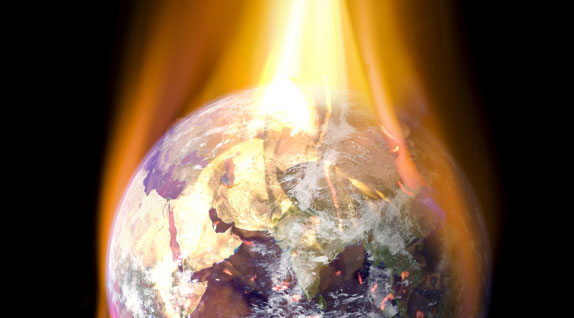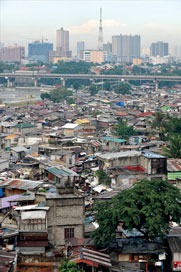 Maksym Filipchuk | Dreamstime.com
Maksym Filipchuk | Dreamstime.com
Article
Problems of every kind plague society, prompting the question: what is in store for the world in 2050? This series presents a picture of the future in light of today’s trends.
Learn the why behind the headlines.
Subscribe to the Real Truth for FREE news and analysis.
Subscribe NowWhat does the future hold? What will the world look like in decades to come? What will life be like for our children—and their children?
These are perhaps some of the biggest questions that confront humanity. Almost everyone at some point in life contemplates them.
Hollywood has its own predictions. Futurologists paint fanciful pictures, with flying cars and robots to assist every human need. Doomsayers see the world being destroyed. Even some of the most renowned minds in the scientific community now urge people to abandon Earth before it is destroyed by nuclear war or by natural disaster. Others see global warming as a contributing factor to man’s supposed destruction.
What picture do current facts and trends paint for the future?
What People Think
In April 2010, the Pew Research Center and Smithsonian magazine polled a group of Americans for their perspective on what the world will be like in 2050.
A majority of people polled believe that advanced scientific development is certain. Eighty-one percent feel computers will probably be able to converse like humans. Concerning cancer, 71 percent think man will find a cure. Sixty-six percent believe artificial limbs will most likely outperform real ones. A majority also believe that space travel will be commonplace for the average person in 40 years.
In addition, most believe that an extinct animal will be brought back to life and mankind will find evidence of life somewhere else in the universe. Forty-eight percent think that a human will be cloned in the decades ahead. Forty percent even believe the technology to read people’s thoughts will exist by 2050!
As to the areas of energy and environment, a large majority believe that our energy will not come from coal, oil and gas in four decades. A similar number—72 percent—believe the world will face a major energy crisis. Sixty-six percent feel the earth will be warmer mid-way through this century.
Regarding war, most of those polled feel that the world will descend into another world war by 2050. A majority also believe America will be attacked with a nuclear weapon.
In summary, people foresee technology advancing, while at the same time they acknowledge that real threats of energy crises—and even world wars—loom on the horizon.
Of those polled, 64 percent are still optimistic about the future, but this number has dropped from 81 percent in a similar poll conducted in 1999. Meanwhile, the number of people who believe the coming decades will be bleak has doubled. Attitudes about the future of the United States and its economy are also becoming more pessimistic.
Finally, 41 percent polled believe Jesus Christ will return within the next 40 years, but even more—46 percent—feel this will not occur.
Starting with the assumption that Jesus Christ will not return by 2050, the questions must be asked: Where will we be by 2050? What do authorities, planners, scientists, educators and global think-tanks foresee? What do today’s trends reveal for the world tomorrow?
While space does not permit a detailed look at every facet of society, let’s paint a picture—a figurative snapshot of Earth, dated AD 2050.
Population
To understand where the world is headed, we must examine how many human beings are on Earth today—and how many will be in 2050.
But to fully appreciate these trends, some basic history is required. First consider that 210 years ago, in 1800, the world population was under 1 billion people. By 1900, the population had grown to 1.65 billion. Fifty years later, the population was over 2.5 billion.
We are currently growing at a rate of 1 billion people every 12 years! And by 2050, the United Nations estimates that the number of human beings on Earth will be over 9.1 billion. In just 100 years, the number of people will have more than tripled! In other words, for every human being that existed just after the Second World War, there will be three—only 40 years from now!
In 1950, there were on average 19 people per square mile. (Realize that much of Earth is uninhabitable, so in actuality this number is far greater.) By 2050, the number of people per square mile will increase to 67.
But many areas of the Western world are not projected to grow nearly as fast as others. For example, Africa was 227 million in 1950, yet it is projected to be almost 2 billion by 2050! For every human being in Africa in 1950, there will be nine in 2050!
This alone provides a glimpse of the challenges mankind will face in the decades ahead.
Changing Demographics
As immigration continues in an increasingly global-village society, the demographics of nations will continue to change, some dramatically. The Associated Press reported, “Minorities make up nearly half the children born in the U.S., part of a historic trend in which minorities are expected to become the U.S. majority over the next 40 years.
“‘Census projections suggest America may become a minority-majority country by the middle of the century. For America’s children, the future is now,’ said Kenneth Johnson, a sociology professor at the University of New Hampshire…”
Similarly, Europe faces significant demographic changes in the next four decades. The Telegraph reported in an article titled “Muslim Europe: the demographic time bomb transforming our continent”: “Britain and the rest of the European Union are ignoring a demographic time bomb: a recent rush into the EU by migrants, including millions of Muslims, will change the continent beyond recognition over the next two decades, and almost no policy-makers are talking about it.
“The numbers are startling. Only 3.2 per cent of Spain’s population was foreign-born in 1998. In 2007 it was 13.4 per cent. Europe’s Muslim population has more than doubled in the past 30 years and will have doubled again by 2015. In Brussels, the top seven baby boys’ names recently were Mohamed, Adam, Rayan, Ayoub, Mehdi, Amine and Hamza.”
Such change is already impacting politics, with right-wing politicians receiving more and more votes. For example, in the Netherlands, Geert Wilders and his Party for Freedom did well in the 2010 national elections. The party came in third, and increased their seats from nine to 24 (of a total of 150 seats in the Dutch Parliament). Mr. Wilders is known worldwide for his anti-Islamic views, including having compared the Koran to Adolf Hitler’s Mein Kampf.
What instability will such dramatic demographic changes cause by 2050? If Dutch voters are already reacting, what will occur in the years ahead with all nations experiencing such changes?
The Telegrapharticle continues: “The study for the US Air Force by Leon Perkowski in 2006 found that there were at least 15 million Muslims in the EU, and possibly as many as 23 million. They are not uniformly distributed, of course. According to the US’s Migration Policy Institute, residents of Muslim faith will account for more than 20 per cent of the EU population by 2050 but already do so in a number of cities. Whites will be in a minority in Birmingham by 2026, says Christopher Caldwell, an American journalist, and even sooner in Leicester. Another forecast holds that Muslims could outnumber non-Muslims in France and perhaps in all of western Europe by mid-century. Austria was 90 per cent Catholic in the 20th century but Islam could be the majority religion among Austrians aged under 15 by 2050, says Mr Caldwell.”
Think about the previous sentence! Will the Catholic church ultimately tolerate such a dramatic shift? Having traveled to Austria and Bavaria (the birthplace of Pope Benedict XVI), and having walked through its enormous cathedrals (including where the current pope served as Archbishop of Munich), I can attest to the fact that this area of Europe is intensely Catholic. Again, will such demographic changes be accepted? If not, what will happen in the decades to come?
Children in Need
Consider the current state of the world’s children. Over 25,000 under age five die each day! One of the goals of the UN is to reduce child mortality. Since child death rates have decreased over the past few decades, one could reasonably estimate they will continue to decline.
The UN estimates the child mortality rate will fall from 71 per 1,000 births to 31. While one could argue that this view is too optimistic, this still means that over 3.7 million children will die each year at the midpoint of this century!
The cumulative number of deaths from 2010 through 2050, taking into account the decrease stated above, is over 250 million children—more than a quarter billion.
Consider other UNICEF statistics:
- 2.5 billion people still lack access to improved sanitation facilities
- 1 billion children are deprived of one or more services essential to survival and development
- 129 million children under five in developing regions are underweight for their age
- 500 million to 1.5 billion children have been affected by violence
- 163 million children lost one or both parents in 2008
- 70 million women and girls in 29 countries have experienced female genital mutilation/cutting
Is there any doubt all of this will continue through 2050?
Water Scarcity
Water is one of the most important resources on Earth. Across the globe, nations are preparing for water scarcity. India, one of the most populous countries in the world, is bracing itself for shortages as it expects its demand to double by 2050. IRC International Water and Sanitation Centre reports that almost every Arab country will face water shortages in the coming decades.
Sandia Lab News, a publication connected to the U.S. National Nuclear Security Administration, revealed, “By 2025 more than half the nations in the world will face freshwater stress or shortages and by 2050 as much as 75 percent of the world’s population could face freshwater scarcity.”
The article quoted Mike Hightower and Suzanne Pierce, two Sandia water experts, from a report they published in the journal Nature.
“This growing international water crisis is forcing governments to rethink how they value and use and manage water, especially because economic development hinges on water availability,” they stated in the article. “Drinking water supplies, agriculture, energy production and generation, mining, and industry all require large quantities of water. In the future, these sectors will be competing for increasingly limited freshwater resources, making water supply availability a major economic driver in the 21st century.”
A July 2010 study by the Natural Resources and Defense Council revealed that nearly one-third of counties in the continental United States will face higher risks of water shortages in the future. Demand may exceed supply in the following states: Arizona, Arkansas, California, Colorado, Florida, Idaho, Kansas, Mississippi, Montana, Nebraska, Nevada, New Mexico, Oklahoma and Texas.
The National Geographic April 2010 article “Water Is Life,” stated: “Civilization has been similarly slow to give up on our myth of the Earth’s infinite generosity. Declining to look for evidence to the contrary, we just knew it was there. We pumped aquifers and diverted rivers, trusting the twin lucky stars of unrestrained human expansion and endless supply. Now water tables plummet in countries harboring half the world’s population. Rather grandly, we have overdrawn our accounts.”
The article also states: “With 83 million more people on earth each year, water demand will keep going up unless we change how we use it…Women in developing countries walk an average of 3.7 miles to get water…In 15 years, 1.8 billion people will live in regions of severe water scarcity.”
Feeding 9 Billion People
Food production will be another mammoth challenge in 2050. Studies reveal that food production will need to increase by 70 percent to feed the over 9 billion people on Earth. While many planners are cautiously optimistic that this can be done, one must understand that today people are starving all over the world.
More than one-sixth—over 1 billion—of the world population is hungry, World Food Programme (WFP) Executive Director Josette Sheeran announced in 2009.
“Today is world food day,” Ms. Sheeran said, while holding an empty cup, “but for one out of six people on earth they are not even sure that they can fill this cup today. So I am going to rename this as the ‘no food day’ and call upon the world to remember that there are people who have nothing in the cup. One out of six people on earth will go to bed hungry tonight” (euronews).
In 2008, the crisis became apparent after the Food and Agriculture Organization (FAO) and WFP reported 100 million more people became undernourished—the highest number in four decades.
According to the UN, Asia and the Pacific Region have the most starving people: 642 million. Sub-Saharan Africa is second with 265 million, followed by Latin America and the Caribbean islands with 53 million, then the Mideast and North Africa with 42 million. The number of starving people in developed countries make up the remaining 15 million.
Children appear to be the hardest hit by the catastrophe. Dr. Otive Igbuzor, head of International Campaigns for ActionAid International, reported that a child dies of malnutrition every six seconds. Dr. Igbuzor calls it a world emergency requiring immediate action from both developing and developed nations.
Although the UN achieved gains in the battle against hunger in the 1980s and early 1990s, the number of undernourished people began skyrocketing in 1995, reaching 1.02 billion this year. (Meanwhile, the same number of people on Earth are overweight!)
To avert the crisis, UN agencies estimate developing nations will need over $82 billion in agricultural aid for developing countries if the world’s projected 9.1 billion people by 2050 are to be adequately fed. To avert disaster, the world must increase agricultural production by 70 percent in the next 41 years.
But the FAO warned that the UN Millennium Development Goals, which aim to halve the number of malnourished people by 2015, can only be met through a more focused, broad-based approach with worldwide investment in agriculture and economic safety nets for poorer countries.
Ask: how many more will starve in the years beyond 2015?
Some of the other problems predicted for the near future include limited and diminishing arable land, deforestation, urbanization, disappearing family farms, degradation of land and water, irrigation problems, waste, the extinction of certain types of crops, the increased intensity and frequency of severe weather (which causes flooding and seasonal loss of crops), and changes in climate. At the same time, 1.6 acres of rainforest—often called the “lungs of the world” as they produce so much oxygen—are disappearing through logging every second. Almost half of the Amazon rainforest will be gone by 2050!
Other Problems
Consider the crimes that will be committed from now until 2050. How many robberies—rapes—murders will take place?
Also, how many abortions will occur? Today, approximately 46 million abortions are carried out yearly. If the current trend continues, 1.8 billion unborn babies will be murdered in the next 40 years!
Then there are divorce rates. How many families will split up in the next four decades?
Which superbug will break out and cause the next crippling pandemic? How many millions will die from this alone?
What about these fundamental questions: What if another world war breaks out, as many in the survey previously referenced believe? What will happen if a rogue nation uses a nuclear weapon on a populous city? How many millions—or tens of millions—will be vaporized in an instant? How many lives will be cut short with modern weapons of war?
 Mark Ralston/AFP/Getty Images
Mark Ralston/AFP/Getty Images
Intangibles
Now consider the intangibles—which cannot be explained through statistics, facts or projections. How much suffering takes place each year? How many uncounted rapes occur daily? How many tears do human beings shed as a result of untold pain and anguish? What will be the cumulative effect of all of this misery by the year 2050?
Think. World events are creating a perfect storm of destruction. Newspaper headlines trumpet financial woes, increasing disease and starvation, worsening weather conditions, political upheaval and nations on the brink of war—all worse than ever before.
The ultimate question is: will any of this change by 2050? Looking at the path we are following, the answer is NO. While some conditions may temporarily improve, the overall trends always evidence that humanity as a whole is on a downward spiral. This fact cannot be denied, as the track record of history proves.
The figurative caption for the snapshot of 2050 is the same as it has always been: mankind cannot solve its problems. (Read our booklet Why Man Cannot Solve His Problems.)
For a different picture of 2050, see Scenario II: Beauty and Harmony of this series.
There is hope.



